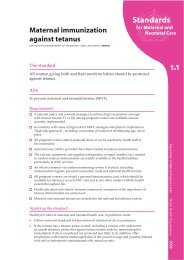1uvZ4zN
1uvZ4zN
1uvZ4zN
You also want an ePaper? Increase the reach of your titles
YUMPU automatically turns print PDFs into web optimized ePapers that Google loves.
Volume III<br />
Chapter ONE<br />
4. Thus, although the government had as early as 1992 acknowledged that ethnic<br />
tension was rife in the country it did not take adequate measures to address the<br />
issue. The impact of this failure would, coupled with other factors, contribute to the<br />
vicious and large scale violence that took place in the country following the disputed<br />
presidential election of 27 December 2007. The violence had a distinct ethnic<br />
dimension. Therefore, with 1,133 people dead, and more than 350,000 internally<br />
displaced during the PEV, the phenomenon of ethnic tension could not be ignored<br />
anymore.<br />
5. As such, addressing the question of ethnic tension and violence was top in the<br />
agenda of the Kenya National Dialogue and Reconciliation. The NCIC and this<br />
Commission were established with complementary roles in dealing with the<br />
problem of ethnic tension.<br />
6. For this reason, section 6(s) of the TJR Act mandated the Commission to ‘inquire<br />
into the causes of ethnic tension and make recommendations on the promotion of<br />
healing, reconciliation and coexistence among ethnic communities’.<br />
7. This Chapter documents the main causes and effects of ethnic tension in<br />
Kenya. The chapter is based mainly on testimonies that the Commission heard<br />
during its hearings across the country. In addition to holding such hearings, the<br />
Commission also organized a thematic hearing on ethnic tension and violence on<br />
2 February 2012 in Nairobi. During this thematic hearing the Commission heard<br />
presentations by experts and relevant institutions such as: the National Cohesion<br />
and Integration Commission (NCIC). The objective of the thematic hearing was<br />
well summarized by Commissioner Berhanu Dinka during the opening of the<br />
hearing. He said:<br />
In the last ten months, the Commission has travelled the length and breadth of this<br />
country. We have listened to testimonies of victims and witnesses of ethnic clashes and<br />
political or electoral violence. The stories are sad and revealing. Today, the thematic<br />
hearing seeks to further interrogate the issue of ethnicity and its nexus with violence,<br />
governance, political transition and distribution of resources. 5<br />
8. This Chapter should be read together with two other Chapters contained in<br />
this Report: The Chapter on ‘Economic Marginalisation and Violations of Socio-<br />
Economic Rights’ which deals in great detail with the nexus between ethnic<br />
relations and economic marginalisation; and the Chapter on Land and conflict<br />
which deals in great details with the nexus between ethnic relations and land<br />
relate grievances. The next Chapter in this Volume focuses on a case study of the<br />
intersection between ethnic relations, land and politics.<br />
5. TJRC/Hansard/Public Hearing/Thematic Hearing on Ethnic Tension and Violence/Nairobi/2 February 2012/p. 2<br />
REPORT OF THE TRUTH, JUSTICE AND RECONCILIATION COMMISSION<br />
3






